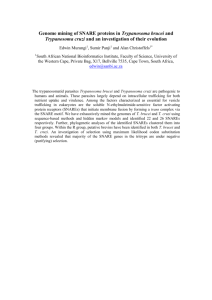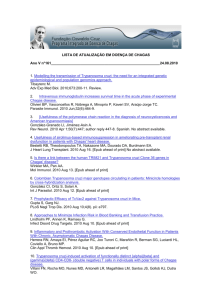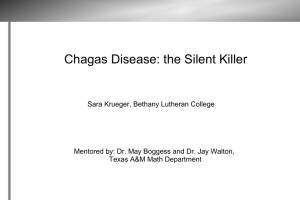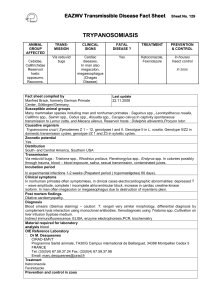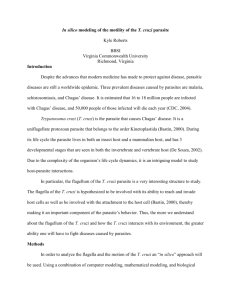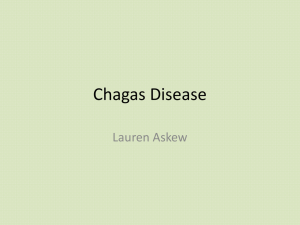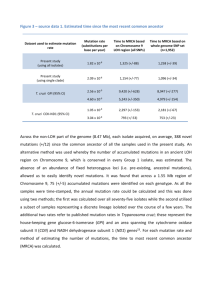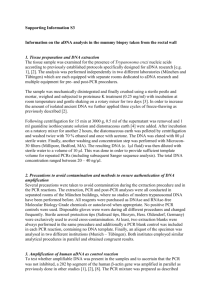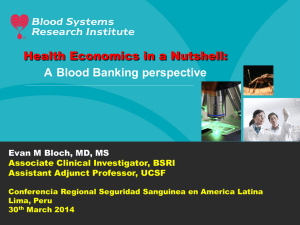Volume 24 - No 12: Trypanosoma
advertisement
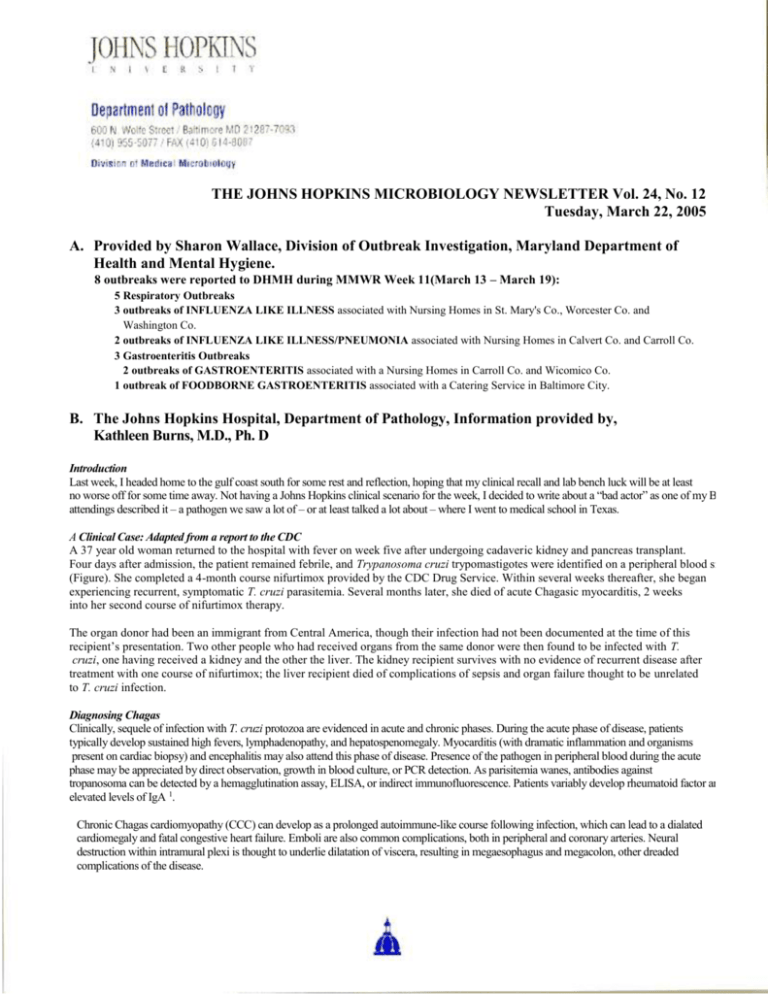
THE JOHNS HOPKINS MICROBIOLOGY NEWSLETTER Vol. 24, No. 12 Tuesday, March 22, 2005 A. Provided by Sharon Wallace, Division of Outbreak Investigation, Maryland Department of Health and Mental Hygiene. 8 outbreaks were reported to DHMH during MMWR Week 11(March 13 – March 19): 5 Respiratory Outbreaks 3 outbreaks of INFLUENZA LIKE ILLNESS associated with Nursing Homes in St. Mary's Co., Worcester Co. and Washington Co. 2 outbreaks of INFLUENZA LIKE ILLNESS/PNEUMONIA associated with Nursing Homes in Calvert Co. and Carroll Co. 3 Gastroenteritis Outbreaks 2 outbreaks of GASTROENTERITIS associated with a Nursing Homes in Carroll Co. and Wicomico Co. 1 outbreak of FOODBORNE GASTROENTERITIS associated with a Catering Service in Baltimore City. B. The Johns Hopkins Hospital, Department of Pathology, Information provided by, Kathleen Burns, M.D., Ph. D Introduction Last week, I headed home to the gulf coast south for some rest and reflection, hoping that my clinical recall and lab bench luck will be at least no worse off for some time away. Not having a Johns Hopkins clinical scenario for the week, I decided to write about a “bad actor” as one of my Baylor attendings described it – a pathogen we saw a lot of – or at least talked a lot about – where I went to medical school in Texas. A Clinical Case: Adapted from a report to the CDC A 37 year old woman returned to the hospital with fever on week five after undergoing cadaveric kidney and pancreas transplant. Four days after admission, the patient remained febrile, and Trypanosoma cruzi trypomastigotes were identified on a peripheral blood smear (Figure). She completed a 4-month course nifurtimox provided by the CDC Drug Service. Within several weeks thereafter, she began experiencing recurrent, symptomatic T. cruzi parasitemia. Several months later, she died of acute Chagasic myocarditis, 2 weeks into her second course of nifurtimox therapy. The organ donor had been an immigrant from Central America, though their infection had not been documented at the time of this recipient’s presentation. Two other people who had received organs from the same donor were then found to be infected with T. cruzi, one having received a kidney and the other the liver. The kidney recipient survives with no evidence of recurrent disease after treatment with one course of nifurtimox; the liver recipient died of complications of sepsis and organ failure thought to be unrelated to T. cruzi infection. Diagnosing Chagas Clinically, sequele of infection with T. cruzi protozoa are evidenced in acute and chronic phases. During the acute phase of disease, patients typically develop sustained high fevers, lymphadenopathy, and hepatospenomegaly. Myocarditis (with dramatic inflammation and organisms present on cardiac biopsy) and encephalitis may also attend this phase of disease. Presence of the pathogen in peripheral blood during the acute phase may be appreciated by direct observation, growth in blood culture, or PCR detection. As parisitemia wanes, antibodies against tropanosoma can be detected by a hemagglutination assay, ELISA, or indirect immunofluorescence. Patients variably develop rheumatoid factor and elevated levels of IgA 1. Chronic Chagas cardiomyopathy (CCC) can develop as a prolonged autoimmune-like course following infection, which can lead to a dialated cardiomegaly and fatal congestive heart failure. Emboli are also common complications, both in peripheral and coronary arteries. Neural destruction within intramural plexi is thought to underlie dilatation of viscera, resulting in megaesophagus and megacolon, other dreaded complications of the disease. A peripheral blood smear photograph illustrating T. cruzi trypomastigotes. The trypomastigotes invade a diversity of cells and are differentiated in amastigotes. Amastogote development in macrophages can produce trypomastigotes for release into the circulation. (Photo from the case described above, taken from http://www.cdc.gov/mmwr/, The Center for Disease Control Morbidity and Mortality Weekly Report website 2.) Geographic Spread and Iatrogenic Infection Classically, the Chagas-causing organism is transmitted by a triatomine hematophagous insect from domestic animals to humans; the disease is endemic to South America and Mexico. In these parts of the world, it is considered among the most serious of parasites, infecting estimates of 17 million people and causing tens of thousands of deaths each year. T. cruzi is being found increasingly in the Southern United States, however, and is becoming an opportunistic pathogen in immune compromised patients receiving organ and blood product donations in our nation and to our south 3-5. ELISA screening of blood products is routine in some countries in South America, including Brazil. Infectious disease researchers are exploring instituting such screens of the U.S. blood supply as at-risk immigrants are increasingly represented in our donor population and the first transfusion-transmitted cases are being appreciated 8 Hijacking Genomes? The mitochondrion of T. cruzi contains a kinetoplast organelle, comprised of large numbers of maxicircles (23kb) and minicircles (1.4kb) of DNA, and this summer saw a report that this DNA is transferred to infected individuals and becomes integrated into the human genome of host cells 9. Favored integration sites for kDNA include the -hemoglobin gene and LINE retrotransponable elements; it is speculated that this may prompt LINE mobilization within the genome. Nitz et al. suggest both the T. cruzi integration event itself and secondary mobility of LINE sequences have the potential to disrupt essential gene expression or lead to the misexpression of genes or chimeric proteins. Though this is not yet documented in patients or animal models, perhaps such genetic rearrangements are antecedent events for the chronic sequele and autoimmune-mediated cellular destruction associated with Chagas disease. References: 1. Lopez-Antunano FJ, Rangel-Flores H, Ramos C. Diagnosis of Chagas' Disease. Revista Latinoamericana de Microbiología 2000; 42:121-129. 2. Center for Disease Control Morbidity and Mortality Weekly Report. From http://www.cdc.gov/mmwr/,. 3. Altclas J, Jaimovich G, Milovic V, Klein F, Feldman L. Chagas' disease after bone marrow transplantation. Bone Marrow Transplant 1996; 18:447-8. 4. de Oliveira Santos E, dos Reis Canela J, Gomes Moncao HC, Guedes Roque MJ. Reactivation of Chagas' disease leading to the diagnosis of acquired immunodeficiency syndrome. Braz J Infect Dis 2002; 6:317-21. 5. Cimo PL, Luper WE, Scouros MA. Transfusion-associated Chagas' disease in Texas: report of a case. Tex Med 1993; 89:48-50. 6. Leiby DA, Herron RM, Jr., Read EJ, Lenes BA, Stumpf RJ. Trypanosoma cruzi in Los Angeles and Miami blood donors: impact of evolving donor demographics on seroprevalence and implications for transfusion transmission. Transfusion 2002; 42:549-55. 7. Brashear RJ, Winkler MA, Schur JD, et al. Detection of antibodies to Trypanosoma cruzi among blood donors in the southwestern and western United States. I. Evaluation of the sensitivity and specificity of an enzyme immunoassay for detecting antibodies to T. cruzi. Transfusion 1995; 35:213-8. 8. Winkler MA, Brashear RJ, Hall HJ, Schur JD, Pan AA. Detection of antibodies to Trypanosoma cruzi among blood donors in the southwestern and western United States. II. Evaluation of a supplemental enzyme immunoassay and radioimmunoprecipitation assay for confirmation of seroreactivity. Transfusion 1995; 35:219-25. 9. Nitz N, Gomes C, de Cassia Rosa A, et al. Heritable integration of kDNA minicircle sequences from Trypanosoma cruzi into the avian genome: insights into human Chagas disease. Cell 2004; 118:175-86.
